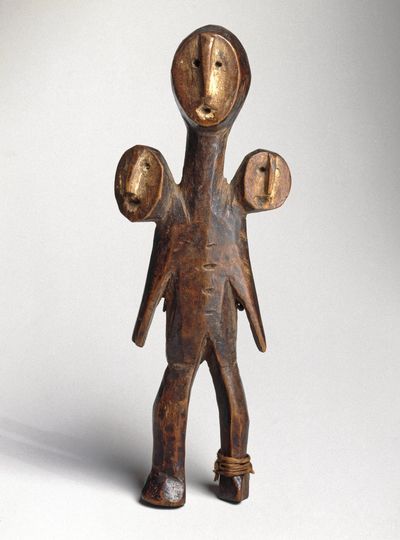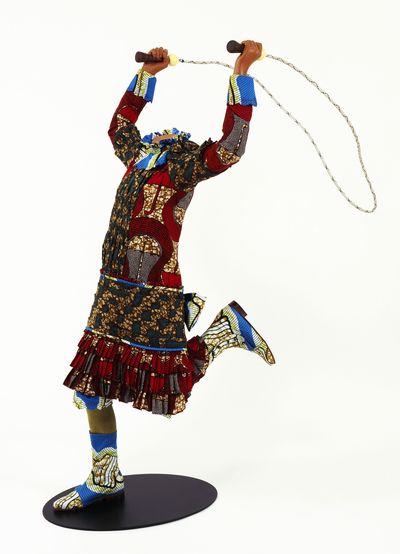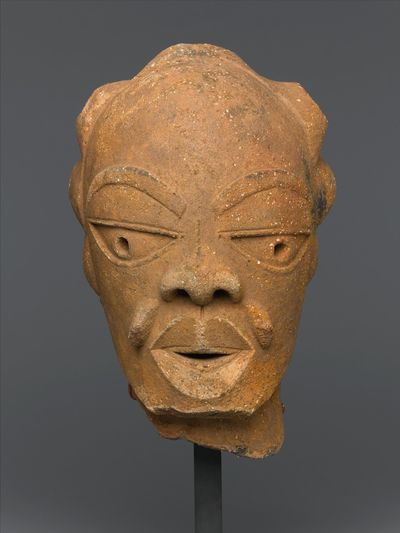Arts of Africa Gives Way to African Innovations
Recent visitors to the museum may have noticed some increasingly dramatic changes to the first floor—first, a new series of walls began to rise in the South Gallery space beyond the Great Hall. As of this week, the African galleries have closed in their current space. But not to worry, our magnificent African collection will soon be returning in African Innovations, a new installation opening August 12.
Construction that will soon be bringing further major changes to the first floor necessitated moving the African galleries from their current home. Faced with a big move, I jumped at the opportunity to put a new spin on one of our most beloved and important collections.

Three-Headed Figure (Sakimatwemtwe). Unidentified Lega artist, 19th century, South Kivu or Maniema province, Democratic Republic of the Congo. Wood, fiber, kaolin. Museum Expedition 1922, Robert B. Woodward Memorial Fund, 22.486
Consisting of over 200 objects in a wide variety of media and genres, including a significant number of works not previously on view, African Innovations aims to build on our groundbreaking history of collecting and exhibiting African art, while moving towards new methods of display and interpretation for the 21st century. The signature work , a three-headed figure (sakimatwemtwe) by an unidentified Lega artist, is emblematic of the theme—with one large head rooted in its own 19th century moment, its additional faces might be said to be looking both back toward the past, and ahead to the future.
African Innovations will arrange the museum’s African galleries chronologically for the first time, to emphasize the continent’s long record of creativity, adaptation, and artistic achievement.
My aim is to emphasize how African art was created to solve important artistic, social, political, and cosmological problems. In so doing, it is my hope that you will further appreciate the works on view as creative solutions with a long history of formal and functional change. I wanted to move away from a primarily geographic presentation that suggested a comparatively static ‘ethnographic present.’
Instead, African Innovations will open and close with galleries focusing on “Crossroads Africa.” The first display, beginning in ancient times, establishes Africa’s ongoing history of artistic dialogue with other parts of the world and neighboring cultures, while the last extends this story into the present (and creates Brooklyn’s first dedicated space for contemporary African art). Highlights of the exhibition range from our Nok head, created as early as 550 B.C.E. to Vessel, by Magdalene Odundo, from 1990. Intriguingly, both our earliest African work and one of our latest were both made from a coiling pottery technique—how’s that for continuity and innovation!?

Skipping Girl. Yinka Shonibare MBE (British, b. 1962). London, United Kingdom, 2009. Life-size fiberglass mannequin, Dutch-wax printed cotton, mixed media. Gift of Edward A. Bragaline and purchase gift of William K. Jacobs, Jr., by exchange and Mary Smith Dorward Fund, 2010.8. © Yinka Shinobare MBE
African Innovations also offers me the opportunity to showcase a number of new acquisitions, such as Skipping Girl, by Yinka Shonibare, whose form evokes the layers of historical connections between European, Asian and African cultures and reveals the constructed nature of “authenticity.”
I’ll leave the other new acquisitions as surprises for the opening in August. Watch this space later this month for further updates on new features in the installation and insights into the construction and design process.

Kevin D. Dumouchelle joined the Brooklyn Museum in 2007. He was promoted to Associate Curator for the Arts of Africa and the Pacific Islands in 2012, having served as Assistant Curator since 2008. In 2011 he conceived and curated African Innovations, the Museum’s first chronological and contextual installation of its African collection. He has also curated a number of exhibitions, and contributed to the writing and editing of a major catalogue of works in the African collection, African Art: A Century at the Brooklyn Museum, published by the Brooklyn Museum in association with DelMonico Books • Prestel in fall 2009. Dumouchelle has published on a range of topics, from architecture and canonical African sculpture to contemporary photography, and he has received numerous fellowships and awards. Dumouchelle earned an M.A. and M.Phil. in Art History and Archaeology from Columbia University, where he taught art history and is completing his Ph.D. He has pursued research in Morocco, Mali, and Ghana, and is the recipient of a first-class Master’s degree in history from Oxford University and a B.S. in Foreign Service from Georgetown University.

